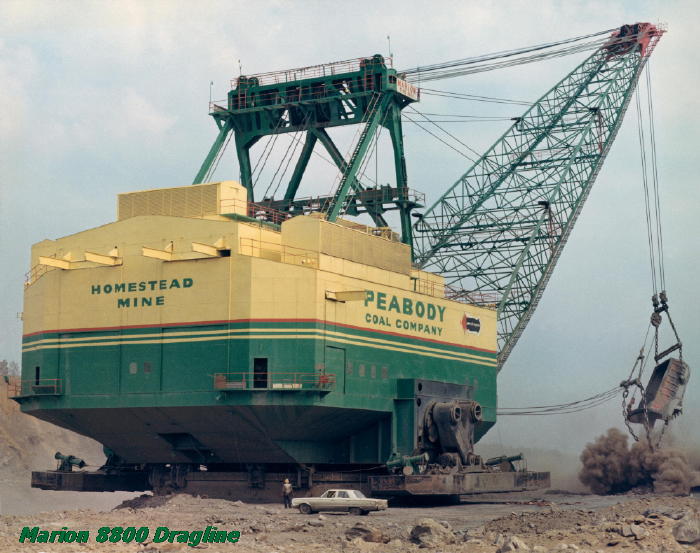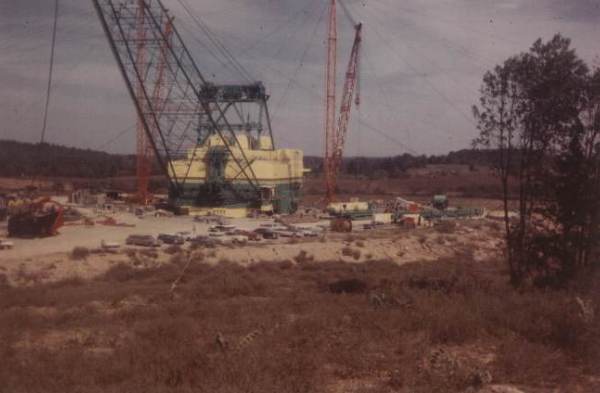
|
Peabody Coal Company Company.
Homestead Mine
Homestead Mine was another of Peabody's strip mines that started in the fifties
and continued operation for many years. The mine was located, mostly to the East
of State Highway 369 or better known as "The Rochester Road". Generally, the
mine paralleled Rochester Road from just South of Western Kentucky Parkway all the
way to the Green River at Rochester. For some reason, Homestead was known as a
quiet mine. I don't know if this is because the miners and the mine just stuck
to business of mining coal or if it was located in a sort of an "Out Of Way"
place. If a person, living in Ohio County, was not associated with Homestead
Mine, whether working for them or in some type business of selling supplies or
material, Homestead Mine just did not seem to exist. There were very few articles
in the local papers or other news media. The mine just produced coal and provided
the miner and his families with a good source of income. Their large shovels
stripped for years and a lot of the time was in view from the Rochester Road, and
yet, there does not seem to be very many pictures of these shovels, the office
complex, the river tipple, nor the garage compound. I would appreciate the loan
of any pictures or information on this large mine from anyone and would certainly
put the material to good use. In reality, I am putting these words together to
form a paragraph or two even though, I know very little about the mine. Help is
needed on this subject. Come on you Coal Miners that once worked for, or even know
much about this great old mine; give me a hand. I can work with you on getting out
a page or two about this mine.
Homestead, on the Green River, was located below Rochester Dam and up river from
Ken Mine Loading Dock. In between the two mines was a little place known as
Chiggerville. Chiggerville was one of those small communities that the residents
hoped would not be discovered by others. Rockport youth and Rockport fishermen
discovered Chiggerville, probably before Chiggerville ever received a name. Or
it may have been the other way around. Chiggerville Camp, or just Chiggerville
on the river, was an area that was conducive to camping and fishing. There was a
flat area where "Camp" could be set up and enough of slope in the river bank where
a boat could easily be launched. Enough game was in the area for the camper to
add to his cooking pot for bonus meals. A few weeks in late summer, the corn
would reach "Roast-an-Ear" stage and add that to a mess of fish-Wow some good
eating! That was then and more or less, in the Norman Rockwell era.
The Green River, at Chiggerville, consisted of some outcropping of rock
and the river depth in this area was relatively shallow. The shallow part of
the river may have been one of the reasons for the good fishing at Chiggerville.
Barges and river traffic continued, as long as their draft was less than eight feet.
Enter the new Homestead River Loading Dock and the need to use barges with nine
foot drafts. A lot of extra coal could be moved for just about the same expense
if a barge with a nine foot draft could be used. The decision was made to cut
out or blast enough of the rock at Chiggerville to accommodate a barge with a nine
foot draft. In this time frame, Bob Adams of Greenville was the explosive foreman
and in charge of drilling and blasting. Peabody sent George Bowling, from River
Queen Mine, to Florida to learn about underwater explosives. He was in charge of
drilling operations of the channel. Working together, Bob and George teamed up
to start the "Chiggerville Rock Removal" operation. Before the river could be
re-channeled for nine feet, Dee Hall, Peabody President, transferred George to a
mine in Ohio. Never-the-less, of men and machines, the river project was completed
and Homestead was now able to use the barges with a nine foot draft and all were
happy. Well, I don't know the "River Story" from fish and the fisherman prospective,
thus will keep that on hold for the time being.
For most of the period of time that Homestead Mine was operational, I and countless
others hunted and fished on Homestead Mine property. In the nineteen-fifties era,
I hunted and fished over much of Ohio and Muhlenberg Counties and I had a few
favorite hunting and fishing places in the area where Homestead Mine was located.
In the later years of Homestead Mine and especially after a state law was passed,
requiring all mines to reclaim the land to near the condition that it was found,
a lot of prime hunting area was created. There was a large area of land where
Homestead overturned the earth and when replaced, created huge, gently rolling
hills with haul roads on either side. The earth was seeded with sufficient grass
seed that produced an excellent habitat for small game and especially dove. For
several years, it seemed that "Grass Seeding" time coincided with the dove season.
A week or so before dove season opened, the "Seeders" got busy and over-seeded enough
areas that made a perfect dove attraction area. And hunters would fill those small
hills and valleys during the Labor Day Weekend. I had never seen such ideal dove
hunting places, nor have I seen it since. A limit of doves: easy, if you took
enough shells. Those times made a lot of us think that we were very good dove
hunters. Since then, reality has set in.

Homestead's Marion 8800 Dragline on construction pad at Homestead Mine. Photographer
was probably David Hope's father, a career Peabody Miner.
A Marion 8800 85-yd. shovel was constructed for the operation of the Homestead
Strip Mine. This mine operated for several decades and had a variety of shovels,
draglines and other equipment. Pictures and information just seems to be almost
non-existent. The picture above is the 8800 sitting on an erection pad in Oct.
1963 at Peabody's Homestead Mine, Beaver Dam, Ky. This machine had a boom failure
after a few years of operation and the question of what to do with the broken
machine, had one of three choices: 1) Repair and continue operation. 2) Shut
down and salvage. 3) Recondition the machine and replace the 85 Yard bucket with
a 100 yd. bucket. The decision was to shorten the boom a little, and install a
100 Cubic Yard bucket and continue operation. I think that this was the first
of the 100 Yard buckets. When Homestead closed, the 8800 was walked to Ken Mine
(Peabody), worked a few years at Ken, and when Ken closed, the Marion 8800 dragline
was scrapped.
A few years before Homestead Mine came into being, the area that was soon to be
Homestead, included a few small towns. Wysox, Chiggerville, Little Bend, Cool
Springs and Shulztown were just a sampling of the area small towns. Some even
had a post office. A few farmers made a living off the ground and a lot of
hunters and fishermen roamed the area during the respective seasons. Guess one
of my most favorite memories was Bull Run Bottoms and squirrel hunting in that
great bottom land. Bull Run Bottoms was located off the Rochester Road and a few
miles past Cool Springs. It was a little difficult to reach by automobile and a
little walking was required. Guess that is one reason that it was so special.
Some squirrel hunters favored the hills and others favored the bottoms. Probably
more squirrels could be harvested on the hillsides, but bottoms, like the old
Bull Run Bottoms, placed me in the bottom land for squirrel hunting. Another good
hunting place and close to Bull Run Bottoms was "Thoroughfare". It was not called
"Thoroughfare Slough" or "Thoroughfare Bottoms, just "Thoroughfare". Actually, it
was a small slough just off the Green River and it was also difficult to reach.
As teenagers, we would pick up a few supplies, chewing tobacco, soft drinks, bologna
and other necessities at Cool Springs and make camp at "Thoroughfare". We would
camp for a day or so, catch a few fish, maybe get a squirrel, and return home content
with life and longing to make another trip. Nothing special about "Thoroughfare";
it was just different.
Another quickie and I will leave room for any items or articles that you miners
send me. Yeah, I am sure that you will! At least, give me a few ideas or items
and I will make the Homestead Page more informative. A few more years before the
end of Homestead, a "Secret" place to catch big bass was discovered by a few of
the local youths. Either accidentally or on purpose, the creek that ran through
Bull Run Bottoms was dammed and a nice small lake was created. This lake just sat
there for years until some of the young fishermen discovered a great fishing lake.
It was fished for a few years with good results and then Homestead lowered the
water level and for a short period of time, big bass and plenty of them were
brought out of that lake. I was a little late in discovering the "Honey Hole" and
missed out on some of the fun.
Will leave some space for more information on Homestead Mine, if and when any
material becomes available.
See you.....
jrd
;~}
|
|
|